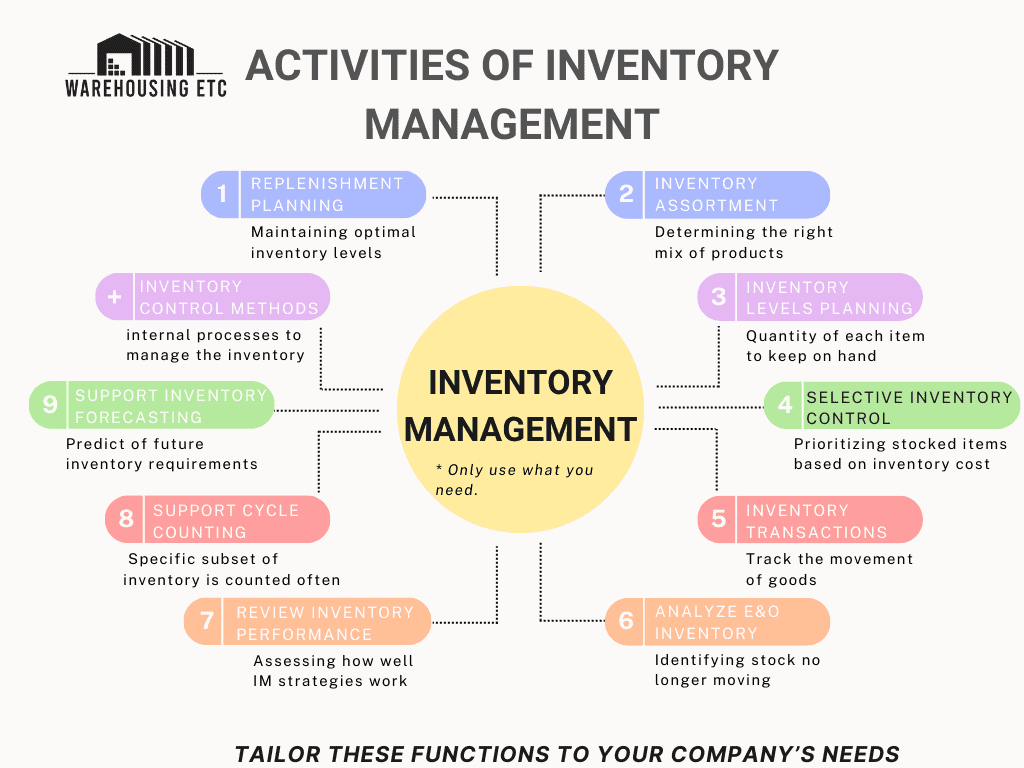In any thriving small business, effective inventory management is the backbone of operational efficiency and growth. It’s a complex yet crucial process, involving everything from stock monitoring and demand forecasting to supplier relationships and order management. Through this guide, we’ll explore the intricate dance of keeping the right stock, at the right time, in the right quantities – avoiding both overstocking and shortages, while maintaining quality and reducing costs.
Whether you’re managing a manufacturing facility dealing with raw materials and finished goods, or a distribution center focused on the efficient shipment of products, this guide addresses the varied challenges you face. We delve into the essentials of inventory control, including quality assurance, cycle counts, and strategies for loss prevention. Learn about the different types of inventory – from raw materials to finished products – and discover best practices for managing each effectively.
Join us as we unravel the complexities of inventory management and control. Whether it’s understanding the roles of replenishment planning, mastering the ABCs of inventory classification, or adopting the latest software solutions, this guide is your go-to resource for transforming your warehouse operations. Let’s embark on this journey to streamline your operation for growth and efficiency.
Table of Contents
- What is the Meaning of Inventory Management?
- What Do You Mean by Inventory Control?
- How Do You Keep Track of Inventory in a Warehouse?
- What Software Do Warehouses Use in Small Business Inventory Management?
- What is the Best Inventory Method for a Small Business?
- How Do You Keep Track of Inventory Quantities?
- Summary
What is the Meaning of Inventory Management?
Inventory management is a function of business and operations management concerned with planning and controlling inventories.
Inventory management involves overseeing the stock levels of goods, from the point of purchase to the point of sale. It includes: Stock Monitoring, Demand Forecasting, Order Management, Supplier Management.

Intro to Inventory Management for Small Enterprises
In the heart of small business operations, especially in warehousing, lies inventory management. It’s an art and science of managing the journey of inventory from purchase to sale, ensuring you have the right stock at the right time.
The activities for inventory management varies from business to business based on the type of business and the products that are sold. For example, manufacturers will have a more complex inventory management process than a wholesale distributor because, typically, manufacturers manage and process raw goods before creating finished goods to sell to customers. In comparison, distributors primarily manage inventory of only Finished Goods and ship them direct to customers.
Broadly speaking, there are 9 inventory management activities used to manage inventory for small businesses. Not all activities are needed by every company and not all functions are done the same way at different companies. Inventory processes are tailored to fit business needs for each company.

1. Replenishment Planning
Replenishment Planning is a strategic approach to maintaining optimal inventory levels. It involves determining the right time and quantity for reordering stock to prevent shortages without overstocking. For example, a small boutique specializing in seasonal fashion must plan its inventory orders in line with changing fashion trends and seasons, ordering summer attire in spring to ensure availability when demand spikes.
Key Considerations:
- Lead Time: The time between placing an order and its delivery. Accurately calculating lead time is critical.
- Demand Forecasting: Predicting sales based on historical data, trends, and seasonality.
- Stock Replenishment Methods: Techniques such as JIT, EOQ, or VMI.
2. Inventory Assortment
Inventory Assortment refers to the process of determining the right mix of products to keep in stock, which is crucial for meeting customer demand and optimizing sales.
Key Aspects:
- Product Variety: Offering a range of products to meet diverse customer needs.
- Stock Depth: Determining how many units of each product to keep in stock.
Strategy:
- Market Analysis: Understand customer preferences and market trends to decide which products to stock.
- Sales Data Review: Use historical sales data to identify which products are in high demand.
Example:
A small specialty coffee shop might stock a variety of coffee beans to cater to different customer preferences but keep a larger stock of the best-selling blends.
Another example, a small electronics store might always stock popular items like smartphones (Make-to-Stock) but order less common accessories only when a customer requests them (Make-to-Order).
3. Inventory Levels Planning
This involves determining the quantity of each item that a business should hold to meet customer demand without incurring excess costs.
- Safety Stock: Extra inventory to guard against stockouts.
- Reorder Point (ROP): The inventory level at which a new order should be placed.
- Economic Order Quantity (EOQ): The ideal order quantity to minimize total inventory costs.
Example:
A home appliance store might hold a higher Safety Stock of popular items like microwaves around the holiday season.
4. Selective Inventory Control
Selective Inventory Control is about prioritizing management efforts on different stock items based on their impact on overall inventory costs and sales.
- ABC Analysis: This categorizes inventory based on its value and frequency of use. ‘A’ items (high value, low frequency), ‘B’ items (moderate value and frequency), and ‘C’ items (low value, high frequency).
- XYZ Analysis: Focuses on the variability in demand, with X being very consistent, Y less so, and Z being the most unpredictable.
Example:
A small auto parts retailer might categorize high-value engine parts as ‘A’, regularly used accessories like air filters as ‘B’, and fast-moving, low-cost items like wiper blades as ‘C’.
Learn more about selective inventory control and inventory management for small businesses.
5. Inventory Transactions
Inventory Transactions track the movement of goods through the supply chain. It includes recording each receipt, sale, return, or use of inventory.
Key Transactions:
- Receipts: Logging when new stock arrives.
- Sales: Recording each time an item is sold.
- Returns: Keeping track of returned items.
- Usage: Tracking inventory used in production (for manufacturers).
6. Analyze E&O Inventory
E&O (Excess and Obsolete) Inventory Analysis is critical to identifying stock that is no longer moving or is overstocked.
- Excess Inventory: Items that exceed the demand.
- Obsolete Inventory: Items that are no longer sellable or usable.
Strategy:
Regularly reviewing inventory to identify E&O items helps in taking corrective actions, such as discount sales or returns to suppliers.
7. Review Inventory Performance
This involves regularly assessing how well inventory management strategies are working.
- KPI Tracking: Monitoring metrics like Inventory Turnover, GMROI, and Order Accuracy.
- Adjusting Strategies: Based on performance reviews, strategies may need to be adjusted for better efficiency.
8. Support Cycle Counting
Cycle Counting is a crucial inventory auditing procedure where a small subset of inventory, in a specific location, is counted on a specified day.
Importance in Inventory Management:
- Accuracy: Ensures inventory records match the physical stock.
- Error Identification: Helps in quickly identifying and correcting discrepancies without a full inventory recount.
Process:
- Selecting Inventory: Choose different items for counting at regular intervals. This can be based on ABC classification, with ‘A’ items counted more frequently.
- Counting: Physically count the selected items and record the numbers.
- Reconciliation: Compare counted figures with inventory records and investigate any discrepancies.
Example:
A small tool and hardware store might cycle count high-value items like power tools monthly and less expensive items like screws and nails quarterly.
9. Support Inventory Forecasting
Inventory Forecasting is a vital process in inventory management, involving the prediction of future inventory requirements based on historical sales data, market trends, and upcoming events.
Importance in Small Business Operations:
- Demand Planning: Accurate forecasting helps businesses plan for future demand, ensuring they have the right products in the right quantities.
- Resource Optimization: It aids in efficient allocation of resources, including warehouse space and financial investment in inventory.
Process:
- Data Collection: Gather historical sales data, market trends, seasonal patterns, and any other relevant information.
- Analysis: Use statistical methods, such as time series analysis or regression models, to analyze the data and identify patterns.
- Predictive Modeling: Develop a forecast model that predicts future sales. This could involve simple trend analysis or more complex machine learning algorithms, depending on the business size and capability.
Techniques:
- Statistical Methods: Using past sales data to forecast future demand.
- Qualitative Forecasting: Involves using expert opinions, market research, and sales force estimates, especially useful for new products without historical data.
- Quantitative Forecasting: Relies on numerical data and statistical methods. Common techniques include moving averages, exponential smoothing, and seasonality models.
Implementing Technology:
- Inventory Management Software: Many small businesses utilize software tools that offer forecasting features, helping automate and improve accuracy.
- Integration with POS Systems: Integrating forecasting tools with point-of-sale systems can provide real-time sales data, enhancing the forecasting process.
Example:
A small apparel store might use inventory forecasting to determine how many units of seasonal clothing items to order. By analyzing sales data from previous seasons, along with current fashion trends and the local economic climate, they can make informed decisions about their inventory levels for the upcoming season.
Selective Inventory Control Methods & Analysis for SMBs
Selective Inventory Control is a strategic approach in small business inventory management, focusing on prioritizing and managing inventory more efficiently. This method is especially beneficial for warehouse owners, operators, and decision-makers in businesses with 10-500 employees. It enables more focused inventory management, improves efficiency, and can significantly cut costs.
Overview of Selective Inventory Control Techniques
- ABC Analysis: This technique divides inventory into three categories based on value and frequency of use. ‘A’ items are high-value but low in frequency, ‘B’ items are moderate in both, and ‘C’ items are low in value but high in frequency.
- XYZ Analysis: This categorizes inventory based on the predictability of demand, with ‘X’ items having stable demand, ‘Y’ items with somewhat fluctuating demand, and ‘Z’ items with the most unpredictable demand.
- FSN Analysis: Classifies inventory based on the rate of consumption, where ‘F’ is fast-moving, ‘S’ is slow-moving, and ‘N’ is non-moving.
- HML Analysis: Sorts inventory based on the unit price, where ‘H’ signifies high-cost items, ‘M’ for medium-cost, and ‘L’ for low-cost items.
- VED Analysis: This is based on the criticality of the items, dividing them into ‘Vital’, ‘Essential’, and ‘Desirable’.
- SDE Analysis: Categorizes items based on the availability of supply – ‘Scarce’, ‘Difficult’, and ‘Easy’.
- GOLF Analysis: Groups inventory based on ‘Government’, ‘Ordinary’, ‘Local’, and ‘Foreign’ procurement sources.
- S-OS Analysis: Focuses on the seasonal (S) and off-seasonal (OS) aspects of inventory.
- PQR Analysis: Segregates inventory based on the physical volume – ‘P’ for high volume, ‘Q’ for medium volume, and ‘R’ for low volume.
ABC Analysis: A Deep Dive
One of the most widely used techniques is ABC Analysis. It involves categorizing inventory items based on their consumption value, where A items represent approximately 70-80% of consumption value but only about 10-20% of the total items. B items are intermediate, and C items, while large in number, represent a small portion of consumption value.
For example, a small automotive parts supplier might categorize critical engine components as ‘A’ items, regular maintenance parts as ‘B’, and items like screws and bolts as ‘C’. This categorization helps them focus more resources on managing ‘A’ items due to their higher value.
Implementing Techniques in Practice
Small businesses can implement these techniques using tools like MS Excel, where they can create templates for ABC, XYZ, and other analyses. This helps in visualizing inventory categories and making informed decisions.
- Excel Templates: By using ready-made Excel templates, businesses can quickly perform these analyses. For example, inputting inventory data into an ABC analysis template in Excel will automatically categorize items, saving time and reducing errors.
Benefits of Selective Inventory Control
- Efficient Resource Allocation: By understanding which items are more critical or costlier, businesses can allocate resources more effectively.
- Improved Stock Management: Techniques like ABC and XYZ help businesses understand which items need more frequent reordering or tighter control.
- Cost Reduction: By focusing on high-value or critical items, businesses can reduce costs associated with overstocking or stockouts.
Planning Methods for Inventory Replenishment for Small Business Inventory Management
In the competitive world of small business warehousing, mastering inventory replenishment methods is crucial for growth and efficiency. This guide delves into various replenishment strategies, providing a comprehensive understanding for business decision-makers.
1. Understanding Key Replenishment Concepts
- Safety Stock Calculation: Safety stock acts as a buffer against unexpected demand or supply chain delays. It’s calculated based on average demand, lead time, and variability in both.
- Reorder Point (ROP): This is the inventory level at which a new order should be placed to replenish stock. It’s typically calculated based on lead time and average demand.
- Economic Order Quantity (EOQ): EOQ is the ideal order quantity that minimizes total inventory costs, including holding and ordering costs.
- Min-Max System: This approach sets minimum and maximum inventory levels. When inventory falls to the minimum level, a reorder is triggered to bring it up to the maximum level.
2. Planning Strategies in Different Business Environments
- Make-to-Order (MTO): Products are manufactured only after receiving a customer’s order. This strategy reduces inventory holding costs but might increase lead time.
- Make-to-Stock (MTS): This involves producing items based on demand forecasts and holding them in stock. It’s ideal for products with steady demand.
- Assemble-to-Order (ATO): Basic components are produced and stocked, but final assembly is done after receiving a customer’s order.
- Engineer-to-Order (ETO): Products are designed and built entirely to customer specifications. This requires a robust inventory management system for various components.
3. Vendor Managed Inventory (VMI)
- Concept: In VMI, the supplier manages the inventory levels of their products at the customer’s location.
- Benefits: It reduces stockouts and inventory holding costs for the buyer, and improves supplier’s visibility into the buyer’s inventory levels.
- Real-World Example: A classic example is the VMI system implemented by Wal-Mart. By allowing suppliers to directly monitor and replenish stock levels, Wal-Mart significantly streamlined its inventory process, unlocking efficiency and profits.
VMI Case Study: Wal-Mart
- Efficiency & Profits: Wal-Mart’s use of VMI exemplifies how effective inventory management can lead to operational efficiencies and increased profitability. Suppliers manage their own products in Wal-Mart’s warehouses, reducing stockouts and ensuring optimal inventory levels.
4. Practical Application in Excel for Replenishment Planning
Excel File Structure
Using Excel for inventory management is both cost-effective and efficient for small businesses. An Excel file for replenishment planning typically includes several key components and formulas:
- Data Input Sheet: This sheet contains fields to input raw data such as item names, lead times, average demand, demand variability, holding costs, and ordering costs.
- Calculations Sheet: This sheet uses formulas to calculate Safety Stock, ROP, EOQ, and Min-Max levels based on the data input.
- Dashboard/Output Sheet: This sheet presents the results in an easy-to-understand format, often with tables or charts for quick decision-making.

Key Formulas and Their Use
Safety Stock Calculation:
- Formula: Safety Stock = (Maximum daily usage x Maximum lead time in days) – (Average daily usage x Average lead time in days).
- Purpose: To determine the amount of extra stock needed to prevent stockouts.
Reorder Point (ROP) Calculation:
- Formula: ROP = (Average daily usage x Average lead time in days) + Safety Stock.
- Purpose: To identify the inventory level at which a new order should be placed.
Economic Order Quantity (EOQ) Calculation:
- Formula: EOQ = √[(2 x Demand x Ordering Cost) / Holding Cost].
- Purpose: To find the optimal order quantity that minimizes the total inventory cost.
Min-Max Levels Calculation:
- Formula: Min Level = ROP; Max Level = ROP + EOQ.
- Purpose: To maintain inventory levels within these thresholds to balance between overstocking and stockouts.
Practical Example
Imagine a small business that supplies office stationery. The manager uses the Excel file to input data like lead times for different stationery items, their average demand, and associated costs. The Excel formulas then calculate the optimal quantities and timings for reordering each item. This ensures that the business always has sufficient stock of high-demand items like pens and notepads, while also keeping storage costs in check.
Advantages of Using Excel
- Customizability: The Excel file can be tailored to specific business needs and inventory types.
- Cost-Effective: Excel is a low-cost tool available to most small businesses without the need for specialized software.
- Ease of Use: With basic Excel knowledge, business owners can set up and maintain Itheir inventory planning system.
Inventory Management Key Performance Indicators
In the realm of small business inventory management, Key Performance Indicators (KPIs) are vital tools for measuring and improving warehouse operations. They provide insights into various aspects of inventory control, helping decision-makers optimize processes for better efficiency and profitability.
Understanding Key Inventory KPIs and Their Impact
Average Inventory
- Formula: (Beginning Inventory + Ending Inventory) / 2.
- Impact: Helps determine the average amount of inventory held over a time period, indicating trends and aiding in effective inventory level management.
-
Cost of Goods Sold (COGS)
- Formula: Beginning Inventory + Purchases – Ending Inventory.
- Relevance: Offers insights into the direct costs associated with sold inventory, essential for profitability analysis.
-
Inventory Turnover Ratio (ITR)
- Formula: COGS / Average Inventory.
- Significance: Measures the number of times inventory is sold and replaced over a period, reflecting the efficiency of inventory usage.
-
Days On Hand (DOH)
- Formula: (Average Inventory / COGS) x 365.
- Utility: Indicates the average duration inventory remains in stock, aiding in optimizing reorder frequencies and inventory levels.
-
Gross Margin Return on Inventory Investment (GMROI)
- Formula: Gross Margin / Average Inventory.
- Application: Assesses the profit earned for each dollar invested in inventory, an essential metric for evaluating inventory profitability.
-
Inventory Accuracy
- Formula: (Correct Inventory Records / Total Inventory Records) x 100.
- Purpose: Evaluates the precision of inventory records, crucial for maintaining operational efficiency.
-
Excess & Obsolete Inventory (E&O)
- Formula: Total value of inventory that hasn’t sold within a specific timeframe.
- Importance: Identifies inventory that may lead to wastage or unnecessary holding costs, highlighting areas for potential improvement.
-
On-Time Delivery (OTD) & On-Time in Full (OTIF)
- Formula: (Number of On-Time Deliveries / Total Deliveries) x 100 for OTD.
- Impact: Measures the punctuality and completeness of deliveries, reflecting supply chain efficiency.
-
Days of Supply (DOS)
- Formula: (Current Inventory Level / Average Daily Usage).
- Insight: Helps understand how long the current inventory will last under normal sales conditions, essential for demand planning.
Implementing KPIs in Excel
Excel is a great tool for inventory management KPIs and transforms complex data into clear, actionable insights. Here’s a streamlined approach to implementing these KPIs effectively for your small business:
Create a Data Input Sheet:
- Set up a sheet for consistent data entry, including inventory levels, sales, purchases, and dates.
Input Formulas for Key KPIs:
- Implement formulas to automatically calculate KPIs like Average Inventory, COGS, and Inventory Turnover Ratio. For instance, Average Inventory can be calculated with
=(SUM(Beginning Inventory + Ending Inventory)/2).
- Implement formulas to automatically calculate KPIs like Average Inventory, COGS, and Inventory Turnover Ratio. For instance, Average Inventory can be calculated with
Utilize Pivot Tables and Charts:
- Employ pivot tables for data analysis and charts for visualizing trends. This helps in quickly understanding changes in KPIs like DOH and GMROI.
Set Up a Dashboard for Quick Access:
- Create a dashboard within Excel for a snapshot view of crucial KPIs, making regular monitoring and decision-making more efficient.
Maintain and Update Regularly:
- Keep the data up-to-date and periodically review the KPIs to ensure they align with your current inventory strategy.
This approach offers a practical and efficient way for small business warehouse operators to harness Excel’s capabilities for managing inventory KPIs, ensuring both clarity and depth in inventory analysis.
Supply Chain Planning Processes Related to Inventory Control
In the context of small business inventory management, understanding supply chain planning processes is essential. These processes ensure efficient inventory control, critical for warehouse operations. Two key components in this domain are Master Production Schedule (MPS) and Materials Requirement Planning (MRP).

Master Production Schedule (MPS)
- Definition: MPS is a detailed plan that specifies what needs to be produced, in what quantities, and when. It translates the business plan and forecast into a production plan.
- Application: For a small manufacturing unit, MPS would detail the quantities of each product to be produced weekly, balancing demand with production capacity.
- Benefits: MPS aids in efficient resource allocation, reduces production time, and optimizes inventory levels.
Materials Requirement Planning (MRP)
- Definition: MRP is a system for calculating the materials and components needed to manufacture a product. It uses data from the MPS to determine what materials are required, in what amounts, and when they are needed.
- Example: In a small electronics assembly business, MRP would determine the necessary components like circuit boards and wires, based on the MPS for different electronic devices.
- Advantages: MRP helps in maintaining lower inventory levels, reduces waste, and ensures timely availability of materials.
MPS vs MRP
- Focus Differences: While MPS focuses on what and when to produce, MRP is more about ensuring the required materials are available at the right time.
- Interdependency: MPS and MRP are interconnected. MPS sets the production schedule, and MRP ensures the materials needed for that schedule are available.
- Practical Integration: For small businesses, integrating MPS and MRP can lead to streamlined operations. For example, a small bakery using MPS to plan bread production would rely on MRP to ensure the right quantities of flour, yeast, and other ingredients are available daily.
Implementing in Small Business Warehousing
- Software Solutions: Small businesses can utilize various software tools that offer MPS and MRP functionalities, tailored to their scale.
- Customized Approach: While standard MPS and MRP models exist, it’s crucial for small businesses to tailor these plans according to their specific needs, capacities, and market demands.
- Regular Review and Adjustment: Due to the dynamic nature of small businesses, regular reviews and adjustments to MPS and MRP are necessary to respond to market changes.
What Do You Mean by Inventory Control?
Inventory control is a critical aspect of managing a small business warehouse. It involves a set of internal processes focused on maintaining and managing the inventory to ensure efficiency and accuracy in operations.
Key Aspects of Inventory Control
Quality Control:
- What It Entails: Regular inspection of inventory to ensure all goods are in a condition suitable for sale.
- Application: For example, a small clothing retailer regularly checks garments for any damage or defects to maintain quality standards.
Stock Audits and Cycle Counts:
- Purpose: These are periodic verifications of inventory to confirm the accuracy of stock records.
- Process: This might involve counting a portion of the inventory at regular intervals and reconciling the count with inventory records. For instance, a hardware store might perform cycle counts weekly on high-value items like power tools.
Loss Prevention:
- Objective: To implement strategies that reduce inventory shrinkage due to factors like theft, damage, or administrative errors.
- Example: A small electronics store may use security tags on products and conduct regular staff training to minimize theft.
Inventory Classification:
- Strategy: Categorizing inventory based on criteria such as value, turnover rate, or demand variability.
- Benefit: This helps prioritize management efforts. For example, a small auto parts dealer might categorize items into fast-moving essentials and slow-moving accessories, enabling more focused inventory management.
Effective inventory control is not just about maintaining order; it’s a growth driver for small businesses. By ensuring product quality, accurate stock levels, and efficient categorization, businesses can optimize operations, reduce costs, and improve customer satisfaction, all of which contribute to business growth and profitability.
How Do You Keep Track of Inventory in a Warehouse?
For small to medium-sized warehouse operations, efficient inventory tracking is crucial. Understanding how to manage various types of inventory is key to streamlining operations and ensuring business growth. Here’s a detailed guide on tracking different inventory types in a warehouse.
1. Managing Raw Materials
- What They Are: Raw materials are unprocessed items awaiting use in production.
- Tracking Method: Implement a First-In-First-Out (FIFO) system to ensure older stock is used first, preventing material spoilage. Use barcode or RFID systems for real-time tracking and easier reorder management.
2. Handling Work-in-Process (WIP) Items
- Nature of WIP: These are items currently being processed or manufactured.
- Management Approach: Employ real-time tracking systems to monitor the progress of WIP items through different stages of production. This helps in identifying bottlenecks and optimizing production flow.
3. Monitoring Maintenance, Repair, and Operating Supplies (MROs)
- Definition: MROs include tools, spare parts, and equipment used to support production.
- Inventory Strategy: Keep a par level inventory system for MROs, ensuring a minimum stock level is always available. Regularly review usage patterns to adjust these levels as needed.
4. Tracking Finished Goods
- About Finished Goods: These are the completed products ready for sale to customers.
- Tracking System: Use a warehouse management system (WMS) that integrates with sales data. This ensures that finished goods are adequately stocked based on demand forecasts and sales trends.
Implementing Effective Inventory Tracking in Warehouses
- Technology Integration: Utilize modern inventory management software that offers features like real-time tracking, automated reorder alerts, and integration with other business systems (e.g., CRM, ERP).
- Regular Audits: Conduct regular physical inventory counts to verify the accuracy of your tracking system.
- Staff Training: Ensure that all warehouse staff are trained in inventory management best practices and the use of any relevant technology.
Real-World Example
Consider a small manufacturing business that produces electronic gadgets. They use a combination of barcode scanning and a WMS to track their raw materials (like circuit boards and batteries), monitor their WIP items as they move through the assembly line, manage their MROs like soldering tools, and keep a real-time tab on their finished products like smartphones or tablets. This integrated system allows for efficient inventory management across all stages of their production.
What Software Do Warehouses Use in Small Business Inventory Management?
In the modern era of warehousing, leveraging the right software is pivotal for operational efficiency and growth. For small to medium-sized warehouse operations, a range of software systems is available, each serving specific functions that streamline various aspects of warehouse management.
Types of Software Systems in Warehousing:
Warehouse Management Systems (WMS):
- Function: Centralizes control of tasks such as tracking inventory levels, optimizing picking and placing processes, and managing warehouse layouts.
- Benefit: Enhances inventory accuracy, reduces order processing times, and improves customer service.
Transportation Management Systems (TMS):
- Purpose: Manages the transportation aspect of the supply chain, from parcel deliveries to less-than-truckload (LTL) and full truckload (FTL) shipments.
- Advantage: Optimizes route planning, tracks shipments in real-time, and reduces freight costs.
Enterprise Resource Planning (ERP) Systems:
- Role: Integrates various business processes, including inventory management, accounting, HR, and customer relationship management.
- Impact: Provides a holistic view of business operations, aiding in strategic planning and decision-making.
Order Management Systems (OMS):
- Use: Manages the entire order lifecycle from receipt to delivery, ensuring efficient order processing and fulfillment.
- Significance: Streamlines order processing, reduces errors, and improves customer satisfaction.
Inventory Management Systems (IMS):
- Functionality: Focuses specifically on tracking and managing inventory levels, orders, sales, and deliveries.
- Utility: Helps in maintaining optimal inventory levels, avoiding stockouts or overstocking.
Materials Requirement Planning (MRP) Software:
- Objective: Assists in planning manufacturing processes, purchasing, and delivery schedules.
- Benefit: Ensures timely availability of materials, reduces waste, and improves production efficiency.
Real-World Application:
Consider a small e-commerce warehouse that utilizes a WMS to streamline picking and packing processes, an IMS for real-time inventory tracking, and a TMS to efficiently manage its delivery logistics. By integrating these systems, the warehouse optimizes its operations, from inventory control to order fulfillment and shipping.
What is the Best Inventory Method for a Small Business?
Selecting the right inventory method is crucial for small businesses, particularly in warehouse operations. The best method depends on various factors like the nature of the products, business scale, and customer demand. Let’s explore effective inventory methods suitable for small businesses.
Popular Inventory Methods for Small Businesses
First-In, First-Out (FIFO):
- Concept: The first items stocked are the first ones sold.
- Ideal For: Businesses with perishable goods or products that have a shelf life.
- Benefit: Reduces the risk of inventory obsolescence.
Last-In, First-Out (LIFO):
- Application: The most recently produced or purchased items are sold first.
- Suitable For: Non-perishable goods or where the price of goods increases over time.
- Advantage: Can reduce taxable income in times of inflation.
Just-In-Time (JIT):
- Strategy: Inventory is ordered and received as needed, reducing holding costs.
- Perfect For: Businesses with predictable demand and reliable suppliers.
- Impact: Minimizes inventory costs and increases efficiency.
ABC Analysis:
- Approach: Inventory is categorized into three segments (A, B, C) based on importance and value.
- Application: Helps prioritize management focus on the most valuable items.
- Usefulness: Enhances inventory management efficiency and resource allocation.
Dropshipping:
- Model: The seller doesn’t keep goods in stock but transfers customer orders to a third party, who ships directly to the customer.
- Best For: Businesses looking to minimize inventory risks.
- Advantage: Reduces the need for large storage spaces and upfront inventory costs.
Real-World Example & Visualizing the Flow
Consider a small business specializing in seasonal sports equipment. Implementing the FIFO method ensures that they sell the oldest stock first, corresponding to the relevant sports season, thereby reducing the likelihood of unsellable outdated inventory.
Visualizing the Inventory Flow
- Flowchart or Diagram: Create a visual flowchart to illustrate the chosen inventory method in action, clarifying the steps from procurement to sale.
- Dashboard: Use a dashboard in your inventory software to monitor how the inventory moves and performs under your selected method.
How Do You Keep Track of Inventory Quantities?
For small business warehouses, accurately tracking inventory quantities is essential for operational efficiency and customer satisfaction. Here’s a guide on effective methods to maintain precise inventory records.
Implementing a Robust Inventory Tracking System
Utilize Inventory Management Software:
- Features: Choose software that offers real-time tracking, automated alerts for low stock, and detailed inventory reports.
- Benefits: Enhances accuracy, saves time, and allows for informed decision-making.
- Example: A small retail store might use software that automatically updates inventory levels as sales are made, ensuring they always know what’s in stock.
Barcode/RFID Systems:
- Application: Implement barcode or RFID scanning for every item that enters or leaves the warehouse.
- Advantage: Provides accurate, real-time data on inventory levels and reduces the likelihood of human error.
- Real-World Use: In a small manufacturing unit, barcode scanning can track components as they move from raw materials to finished goods.
Regular Stock Audits:
- Process: Schedule regular manual counts of inventory to verify the accuracy of digital records.
- Importance: Helps in identifying discrepancies and maintaining record accuracy.
- Practice: A small business warehouse might conduct monthly audits of high-value items and quarterly audits for the rest of the stock.
Cycle Counting:
- Strategy: Instead of a full inventory count, regularly audit a subset of inventory on a rotating schedule.
- Efficiency: Reduces disruption and is more manageable for small businesses.
- Example: A distributor of electronic parts might cycle count different categories of items each week.
Integrating Tracking with Other Business Processes
- Sales and Purchase Order Integration: Link inventory tracking with sales and purchase order systems for automatic updates upon every sale or receipt of goods.
- Forecasting and Reporting: Use historical data and inventory trends for forecasting future inventory needs.
- Customization and Scalability: Tailor the tracking system to fit the specific needs of your business and ensure it can scale as your business grows.
Summary of Small Business Inventory Management
This is your essential guide to navigating the challenges of inventory management in small and medium-sized warehouse operations. Aimed at helping warehouse owners, operators, and decision-makers, this article brings together a wealth of practical tips and straightforward strategies to enhance your inventory practices.
Fundamentals of Inventory Management: Exploring the importance of inventory management in small business operations, including stock monitoring, demand forecasting, order management, and supplier relationships.
Inventory Control Techniques: Detailed coverage of various inventory control methods, from quality control and cycle counting to loss prevention and inventory classification, ensuring goods are maintained in optimal condition.
Efficient Inventory Processes: Strategies for replenishment planning, inventory assortment, and inventory levels planning, tailored to meet specific business needs and product types.
Selective Inventory Control Methods & Analysis: An in-depth look at techniques such as ABC and XYZ analysis, helping businesses prioritize inventory based on value, frequency, and demand variability.
Advanced Planning Strategies: Insights into vendor-managed inventory (VMI), master production scheduling (MPS), and materials requirement planning (MRP), and how they intertwine to streamline operations.
Leveraging Technology in Inventory Management: Discussion on the role of warehouse management systems (WMS), transportation management systems (TMS), and other software in enhancing inventory accuracy and efficiency.
Optimal Inventory Methods for Small Businesses: Guidance on choosing the best inventory method, such as FIFO, LIFO, JIT, and ABC analysis, based on the nature of products and business scale.
Effective Tracking of Inventory Quantities: Techniques for maintaining accurate inventory records, including the use of modern software, regular stock audits, and cycle counting.
By embracing these strategies and tools, small businesses can enhance their inventory management, leading to improved operational efficiency, cost savings, and ultimately, business growth.










